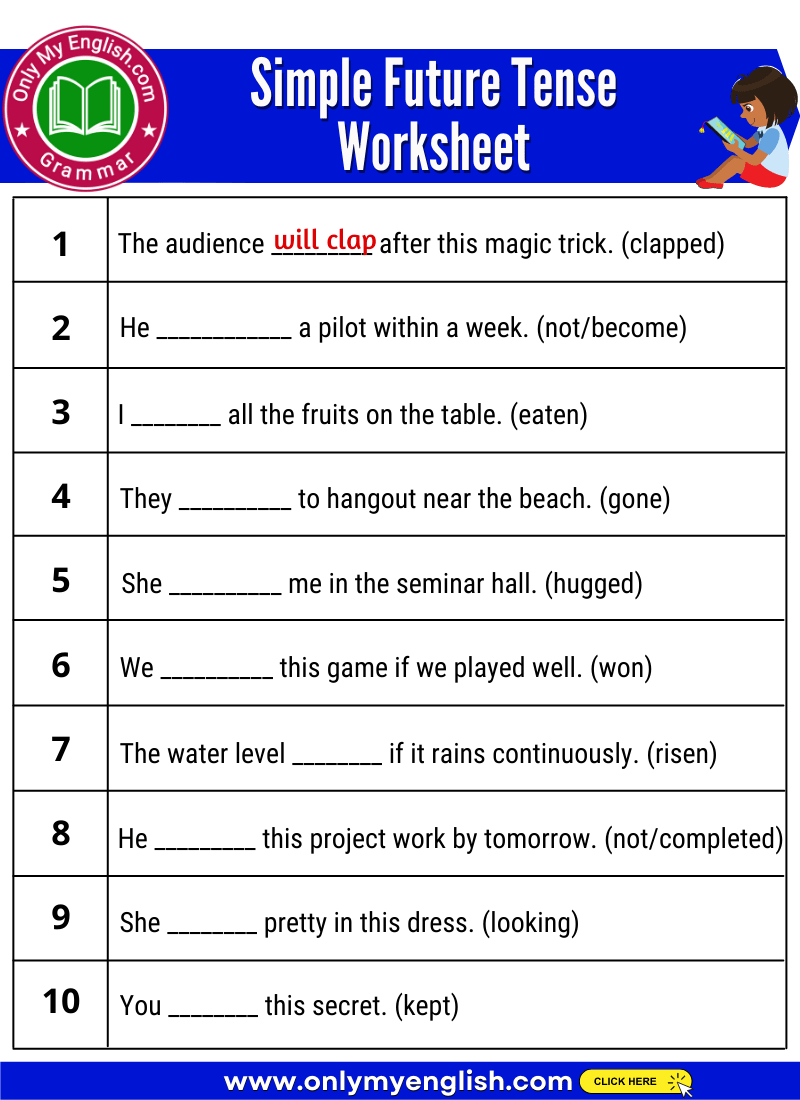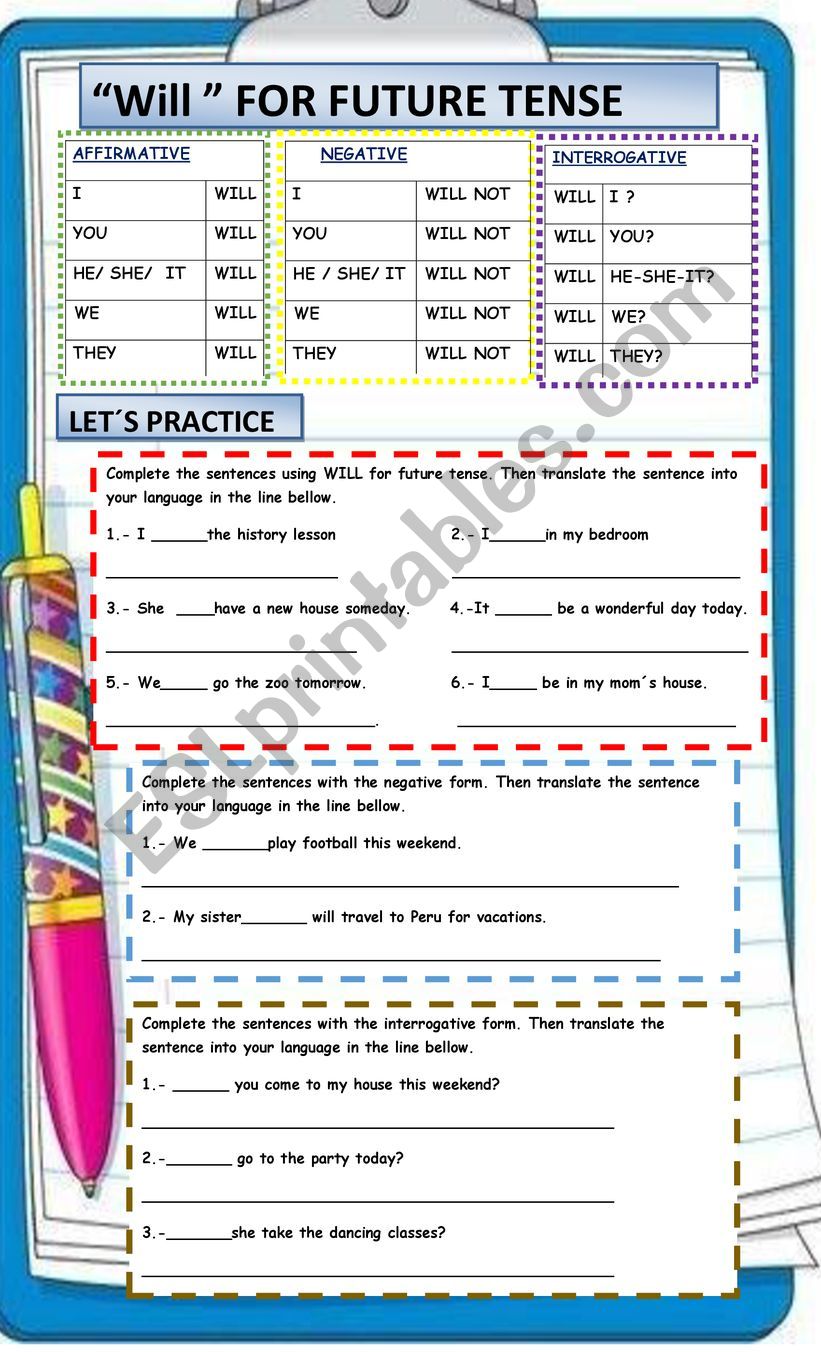
Mastering the Unwritten Future: The Indispensable Role of Grammar Worksheets: Future Tenses
The English language, with its intricate tapestry of tenses, allows speakers to navigate not only the past and present but also the vast and often uncertain landscape of the future. Expressing plans, predictions, intentions, and commitments requires a nuanced understanding of various future forms. For learners, both young and old, grasping these distinctions can be a significant hurdle. This is where well-designed Grammar Worksheets: Future Tenses emerge as an invaluable pedagogical tool, offering structured practice, reinforcement, and the necessary scaffolding to transform complex grammatical concepts into intuitive communication skills.
The Landscape of Future Tenses: More Than Just "Will"

Before delving into the power of worksheets, it’s crucial to appreciate the diverse array of structures English employs to talk about the future. Unlike some languages with a single future tense, English offers several, each carrying subtle yet significant differences in meaning, formality, and implication:

- Simple Future (Will + Base Verb):

- Uses: Spontaneous decisions, predictions (often based on opinion), promises, offers, requests, threats.
- Example: "I will help you with your homework." (Offer) "It will rain tomorrow." (Prediction)

- Be Going To (Be + Going to + Base Verb):
- Uses: Pre-planned intentions, predictions based on present evidence.
- Example: "I am going to visit my grandmother this weekend." (Planned intention) "Look at those clouds! It’s going to pour." (Prediction based on evidence)


- Present Continuous for Future (Be + Verb-ing):

- Uses: Fixed arrangements or appointments, often with a specific time/date.
- Example: "We are meeting at 7 PM tonight." (Fixed arrangement)

- Simple Present for Future (Base Verb / Verb-s):
- Uses: Timetables, schedules, events that are part of a fixed program.
- Example: "The train leaves at 8 AM." (Scheduled event) "The conference starts on Monday."
- Future Continuous (Will Be + Verb-ing):
- Uses: Actions that will be in progress at a specific time in the future.
- Example: "At this time tomorrow, I will be flying to London."
- Future Perfect (Will Have + Past Participle):
- Uses: Actions that will be completed by a certain time in the future.
- Example: "By next year, I will have graduated from university."
- Future Perfect Continuous (Will Have Been + Verb-ing):
- Uses: Actions that will have been ongoing up to a specific point in the future, emphasizing duration.
- Example: "By 5 PM, I will have been working for eight hours."

The sheer number of forms and their contextual nuances present a considerable challenge for learners. They must not only master the grammatical structure but also discern the appropriate usage based on the speaker’s intent and the surrounding context.
The Challenge of Nuance: Why Learners Struggle
Learners often struggle with future tenses for several reasons:
- Overlapping Meanings: The lines between "will" and "be going to" can be blurry, leading to confusion. While both can express predictions, the subtle difference in the basis of that prediction (opinion vs. evidence) requires careful attention.
- Contextual Dependency: The choice of future tense is heavily dependent on context. A simple sentence like "I am having dinner" could refer to a current action or a future arrangement, depending on the adverbs of time used.
- Interference from Native Language: Learners from languages with simpler future tense systems may try to map a single future form onto all English future contexts, leading to errors.
- Production vs. Recognition: Learners might recognize the different future forms but struggle to produce them accurately and appropriately in their own speech and writing.
This is precisely where focused, repetitive, and varied practice becomes critical. And this is precisely why Grammar Worksheets: Future Tenses are not just helpful, but essential.
The Power of Grammar Worksheets: Future Tenses
Grammar Worksheets: Future Tenses serve multiple vital functions in the language learning process:
- Structured Practice: Worksheets provide a controlled environment for learners to practice specific grammatical structures without the pressure of spontaneous conversation. They break down complex rules into manageable chunks.
- Reinforcement: Repetition through varied exercises helps solidify understanding and moves the knowledge from short-term memory to long-term retention.
- Diagnostic Tool: Teachers can quickly identify common errors and areas of confusion by reviewing completed worksheets, allowing them to tailor subsequent instruction. For learners, self-correction with answer keys provides immediate feedback.
- Self-Paced Learning: Worksheets can be completed at the learner’s own pace, accommodating different learning styles and speeds. They are ideal for homework, independent study, or supplementary practice.
- Focus on Form and Meaning: Good worksheets don’t just focus on conjugating verbs; they often include exercises that require learners to choose the correct future form based on the context and implied meaning, thus bridging the gap between form and function.
Designing Effective Grammar Worksheets: Future Tenses
The effectiveness of a worksheet lies in its design. Here are key principles for creating or selecting impactful Grammar Worksheets: Future Tenses:
- Clear Instructions: Ambiguous instructions can frustrate learners and undermine the learning process. Instructions should be concise, explicit, and, where appropriate, include an example.
- Varied Exercise Types: Monotony leads to disengagement. Incorporate a mix of activities:
- Gap-filling: Simple sentences, short dialogues, or paragraphs where learners fill in the correct future form.
- Sentence Transformation: Rewriting sentences using a different future tense (e.g., changing a "will" sentence to a "be going to" sentence, requiring a change in meaning).
- Matching: Matching sentences to their correct future tense category or matching sentence halves.
- Multiple Choice: Selecting the best future form from a given set of options, often requiring careful consideration of context.
- Error Correction: Identifying and correcting mistakes in sentences that use future tenses incorrectly.
- Contextualized Scenarios: Presenting short stories, emails, or dialogue prompts where learners must use appropriate future tenses to complete the narrative.
- Creative Writing/Speaking Prompts: Encouraging learners to write about their future plans, predictions for the world, or hypothetical situations using various future forms.
- Progression from Simple to Complex: Start with exercises that isolate a single future tense, then gradually introduce activities that require distinguishing between two or more tenses, culminating in free production exercises.
- Contextualization and Relevance: Sentences and scenarios should be meaningful and relatable. Using real-world examples, current events, or topics relevant to the learners’ lives makes the exercises more engaging and helps them see the practical application of the grammar.
- Visual Appeal: A clean, uncluttered layout with appropriate use of headings, bullet points, and sometimes relevant images can enhance readability and learner engagement.
- Answer Keys: For self-study or peer-correction, clear answer keys are essential for immediate feedback and independent learning.
Integrating Grammar Worksheets: Future Tenses into a Holistic Learning Strategy
While incredibly beneficial, Grammar Worksheets: Future Tenses should not be the sole component of grammar instruction. They are most effective when integrated into a broader, communicative approach:
- Pre-Worksheet Activities:
- Explanation and Examples: Before assigning a worksheet, teachers should clearly explain the target future tense(s), providing numerous examples in context.
- Guided Discovery: Encourage learners to discover the rules themselves by analyzing example sentences.
- Oral Practice: Engage learners in controlled oral drills or short communicative tasks that use the target tenses.
- During Worksheet Activities:
- Collaborative Work: Allow learners to work in pairs or small groups on some worksheets, fostering peer learning and discussion.
- Teacher Monitoring: Circulate around the classroom, offering support, clarifying doubts, and providing immediate corrective feedback.
- Post-Worksheet Activities:
- Review and Discussion: Go over the answers as a class, discussing common errors and explaining the reasoning behind correct choices.
- Communicative Follow-up: Transition from controlled practice to freer production. Examples include:
- Role-plays: Students plan a trip, a party, or discuss future careers.
- Debates: Debating future technologies or societal changes.
- Presentations: Presenting personal goals or predictions for the coming year.
- Writing Tasks: Writing emails, diary entries, or short stories that necessitate the use of future tenses.
- Personalization: Encourage learners to create their own sentences or scenarios using the target future tenses, making the learning personally relevant.
By combining the structured, focused practice offered by Grammar Worksheets: Future Tenses with dynamic, communicative activities, educators can create a comprehensive learning environment that ensures both accuracy and fluency in using these essential grammatical forms.
Conclusion
The ability to articulate future events is fundamental to effective communication, allowing us to plan, predict, and express our hopes and intentions. While the multiple forms of future tenses in English can initially seem daunting, Grammar Worksheets: Future Tenses provide an indispensable framework for learners to systematically master these complexities. From simple gap-fills that solidify structural knowledge to creative writing prompts that encourage nuanced usage, these worksheets offer the varied, contextualized practice necessary for true comprehension.
When thoughtfully designed and strategically integrated into a broader curriculum, Grammar Worksheets: Future Tenses empower learners to confidently navigate the temporal landscape of English, transforming what might once have been a source of confusion into a powerful tool for expressing the exciting possibilities of what is yet to come. They are not merely exercises on paper; they are stepping stones towards linguistic proficiency and greater communicative freedom.
